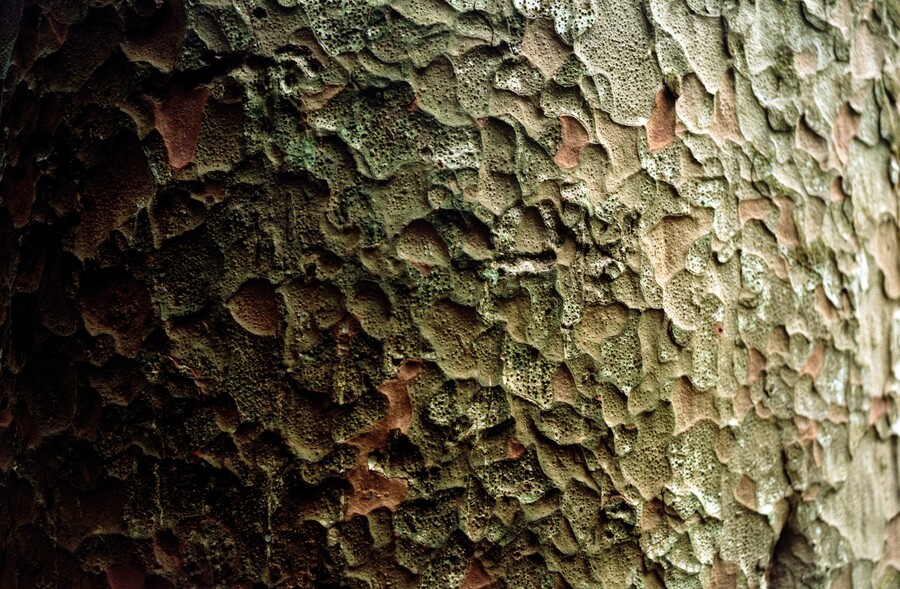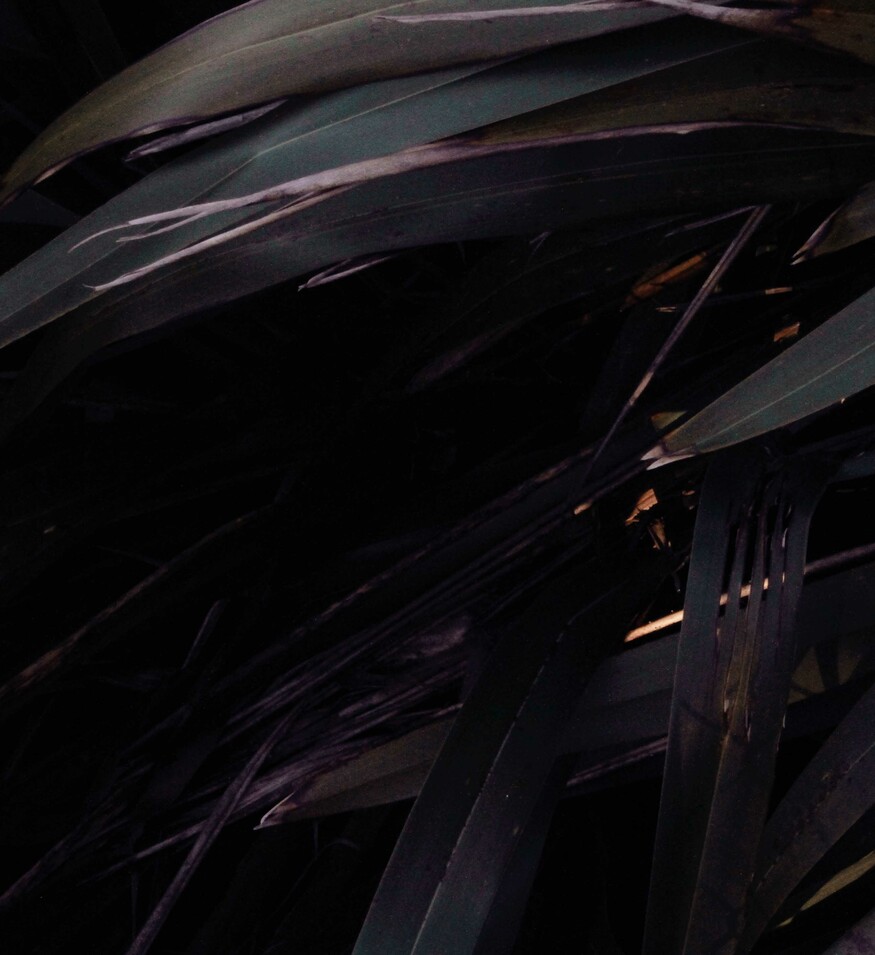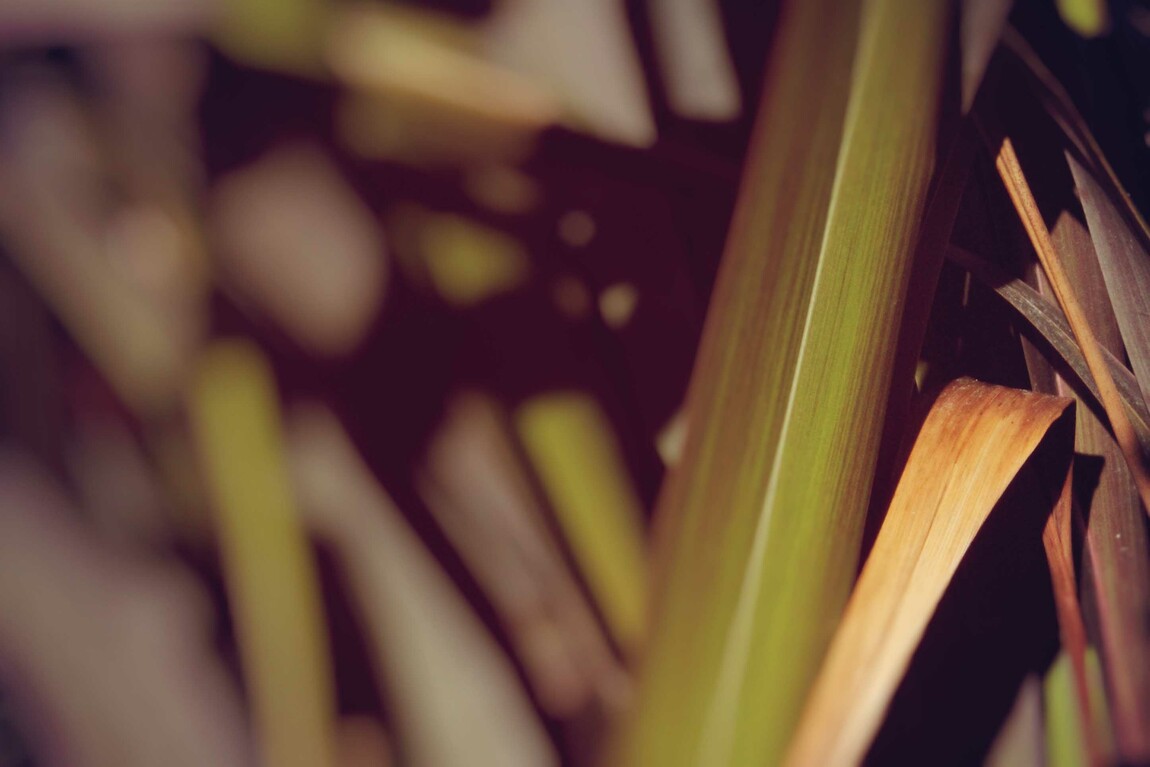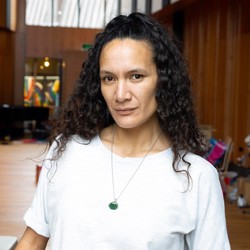Taniwha
Te Hokika Mai

Ngahuia Harrison Te Kiri o Te Tohoraha 2025. Inkjet-printed digital photograph. Courtesy of the artist
Taniwha narratives invoked in small rooms on warm nights of a Hokianga summer, or in big rooms with dirt floors by a Te Reinga river. Hine Kōrako, Poutini, Ngārara Huarau, Whatipū, Ngake and Whātaitai, names repeated and tethered to history from the mouths of generations of sovereign peoples. We wanted more, my tiny cousins and I, we believed in daydreaming and night-flying, viscous trails and portals underground.
“TANIWHA ARE GUARDIANS OF WATERFALLS, WARNINGS TO INTREPID TRAVELLERS, TALL TALES AROUND WARMING FIRES, WHAKAPAPA REPRESENTATIVES, CARETAKERS, FEELINGS, PLANTS…”
But Indigenous temporal loss happened alongside colonial time constructions.1 I began to grow into my scrawny body and, because we’d all internalised colonisation, the distance between sovereign narratives and sovereign peoples’ mouths grew. I no longer dreamed in Māori philosophy or story-weaving,2 instead (conforming to mediocrity) I renamed those taniwha narratives ‘myth’ and ‘legend’ like their childish descriptions, condemning them to a kind of quagmire of “epistemic wilderness”.3
As a teen, the overwhelming darkness took over. I retreat- ed to where my body felt wanted: into the accepted ‘norms’ of Euro-American culture where the stories appeared intelligent and sexy and they wore smoky eyes and heavy mascara. I became inspired by post-war movements like dadaism, the theatre of cruelty, absurdity, postmodernism and surrealism. Enticing creative movements used succulent language such as Breton’s “pure psychic automatism”.4 They included rave culture and impaired alternate realities in the 2000s and I chased them like I was running towards and away from... But there was something familiar sitting in the unsaid and no matter how far I strayed, taniwha narratives lurked in the background. Waiting, I guess, to be recalled. So what do we return to, when we recall taniwha?
Before I explore further, I should explain my present reality. I’m staring at a copy of Taniwha by Robyn Kahukiwa, she has just passed away, passed on, passed over, moved towards or away from. Her absence generates a palpable grief across the country. It’s hard to focus because when you have so few living role models, it is so much harder to let one go.
He Taniwha Hiku Roa 5
I stare harder and longer at the taniwha book; memories arrive in waves. I’ve had to rewind and reset. What started out as a kind of ode to te taiao or the natural world, an informative essay on plants and their whakapapa, has shifted and morphed. I acknowledge the multiple ways taniwha have manifested in my own lived experience: as ecological custodians, epistemic conduit, digital hybrids, physical beings, states of being, intergenerational stories, the descriptor people use to name their alcoholism, emotional haunt. Taniwha are guardians of waterfalls, warnings to intrepid travellers, tall tales around warming fires, whakapapa representatives, caretakers, feelings, plants… And they can be all these things at the same time. The things we return to when we recall taniwha are the things we so often need: a way to be in relation with the world around and within us, not just to make sense of it but to be present within it.

Photo: Kirsty Dunn
“ONE PLANT, ONE TANIWHA, ONE STEP AT A TIME.”
In the plant world, perhaps ironically, most taniwha narratives have gone underground. A few known plants still hold taniwha in their names; parataniwha, poataniwha and taniwhaniwha / papataniwhaniwha. Among harakeke cultivars, some variations carry taniwha-inflected names such as poi-taniwha, matawai-taniwha, and pari-taniwha. All of these plants are rooted in the specific geographies and communities they serve, yet publicly accessible information remains scarce.
This is the first challenge for plant people who are also whakapapa people: our responsibility to research the personal. It requires returning to Māori homes, communities, whānau, hapū and iwi to recover the underground narratives, oral histories, recorded stories and intergenerational records that can help us fill in the missing parts. One plant, one taniwha, one step at a time.
I’m lucky to be living in a moment of powerful Māori scholarship. Unlike some early anthropologists and ethnographers who extracted knowledge without relational accountability, we now move with nuance, with ethics and, importantly, with adherence to the tikaka of the communities from whom taniwha and native plant narratives originate. Furthermore it was those early Māori scholars, institutional or “observant”,6 who created space for my peers and me to continue the intergenerational truth-telling traditions of our ancestors for today. They reminded us that in te ao Māori, te ao hurihuri, te ao kikokiko, we are living in a relational world. Everything is connected. So while academic literature on the specific relationships between taniwha and our native plant species may be limited, there is no shortage of taniwha narratives within the broader matrix of te taiao. In weaving these worlds together, certain themes emerge again and again; ecological sustainability, epistemic integrity, cultural hybridity and a return to our relationship with te taiao, the natural world.
Return(ing) is an important concept – we’ll cycle back at the end.

Photo: Kirsty Dunn
Parataniwha (Elatostema rugosum) translates into English as ‘home of the taniwha’,7 and it thrives in the shadows, damp and dark, under bridges, beside rivers and beneath waterfalls. Never fully in the sun, its leaves are red, bronze, purple and saw edged. This connection between environment and form reinforces the understanding of taniwha as ecological beings, made manifest as both story and physical space. Their presence lurks in the textures, locations and behaviours of native plants. These plants are taniwha.
Tōtara, too, carry intergenerational narratives. Ngamahanga Te Ruahuihui (the tohunga of Te Rotoiti) tells a story of the taniwha Te Upoko o Huraki Tai who cruised through the waters of Lake Rotoiti, embodied by a rākau tupua,8 and sometimes breached in a place called Tapuwaeharuru at the eastern end of the lake. When this happened,
[The] tohunga accompanied by the people would recite prayer to propitiate the spirit of the medium and would also gather items of significance to adorn their guardian as if Te Upoko o Huraki Tai were a living person.
In the northern Wairoa River, a taniwha named Rangiriri, also known as a rākau tupua, defied river currents and drifted against the flow. If a kawau pū / black shag was seen perched upon the back of Rangiriri, this was viewed as a harbinger of death to an important person. Importantly, “one must be a descendant of the right tupuna to see and recognise these tohu.”
Another narrative that positions trees as living agents within taniwha whakapapa traces the origin of creeping plants to the taniwha Tunaroa. In a Kāi Tahu version,10 Tunaroa attempts to kidnap Hine-a-te-repo (woman of the swamp), but she outwits him. Her husband, Māui, takes revenge, capturing Tunaroa and carving him to pieces. His head became the conger eel, his body transformed into kareao (supplejack vine, Ripogonum scandens), his blood stained the trees and birds red, and his tail became the river eels. Here the forest is not exclusively a site of biodiversity, but a domain of taniwha transformation, an embodied, living archive that is compositional, anatomical and consistently reproducing.
This relational ontology speaks to taniwha asserting relational sovereignty. Scholar Justine Kingsbury argues for a serious engagement with taniwha narratives, noting how they encode environmental warnings and risk awareness into place-based story.11 Similarly, geologist and mātauraka Māori scholar Daniel Hikuroa identifies taniwha pūrākau as repositories of geomorphological data: rivers behave like taniwha, shifting, unpredictable and alive with memory.12 These stories call us back to a relational ethic, to heed the rivers and the taniwha within them.
Within the scope of taniwha as multiplicitous and manifold, taniwha cruise the edges of what is possible so that in digital and artistic spaces, taniwha are reasserting them- selves. Warren Williams’s concept of the “Digital Taniwha” envisions data guardians – spiritual kaitiaki in virtual domains.13 Through animation, coding and visual story- telling, rangatahi continue taniwha genealogies in realms of design and digital sovereignty. This is not reinvention but re-emergence. As Alice Te Punga Somerville writes,14 Indigenous futurities unfold in the continuum of ancestral presence and creative insurgency. Today’s taniwha inhabit server farms and syntax, reminding us that protection and warning adapt form but not function. In researching, and being challenged by taniwha, there appears to be no conceptual space or framework from which taniwha are excluded. They are ubiquitous, manifest and evolving.
Ultimately, however, all taniwha return to te taiao. They emerge from and dissolve into whenua. The body, too, is reclaimed, cleansed by rain, consumed by maggots, reborn as soil. Taniwha are cycles, decomposers and regenerators. Hine Korako remains at my marae, steadfast kaitiaki taniwha of Te Reinga. She is a protector, and she too was betrayed.
So again, what do we return to when we recall taniwha? We return to metabolising grief through ecology. We return to kāhere and te taiao, the natural world to which we have come, belong, are remembered by and will end our cycles. We return to sovereignty, to dignity, to play and curiosity, we return to joy.
We return to ourselves.





